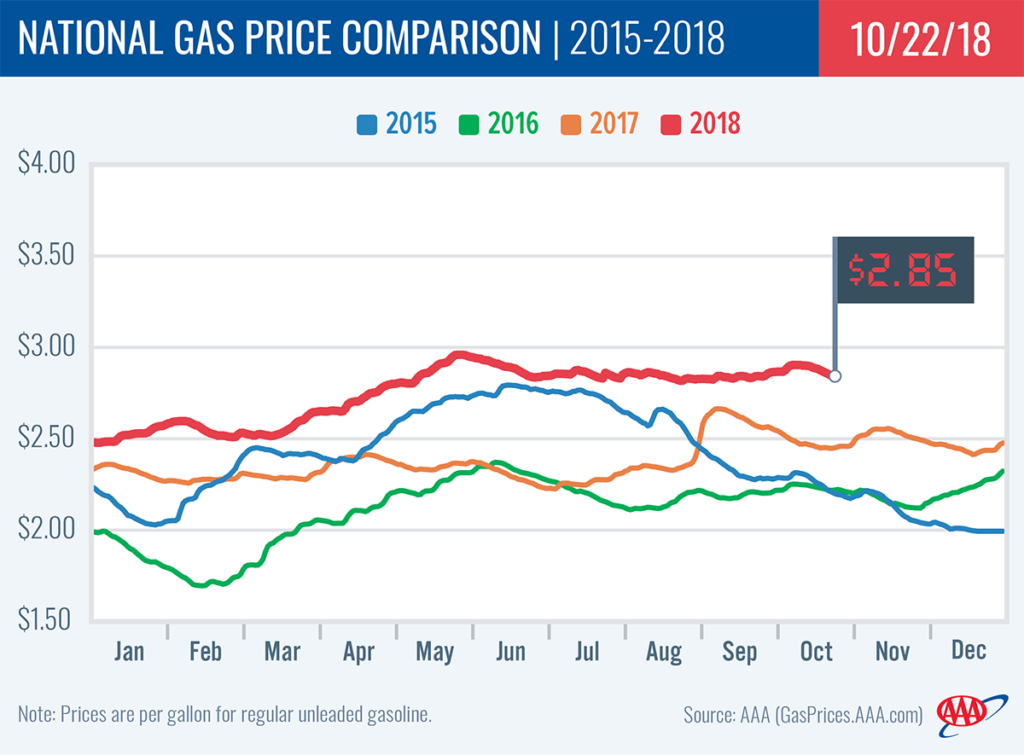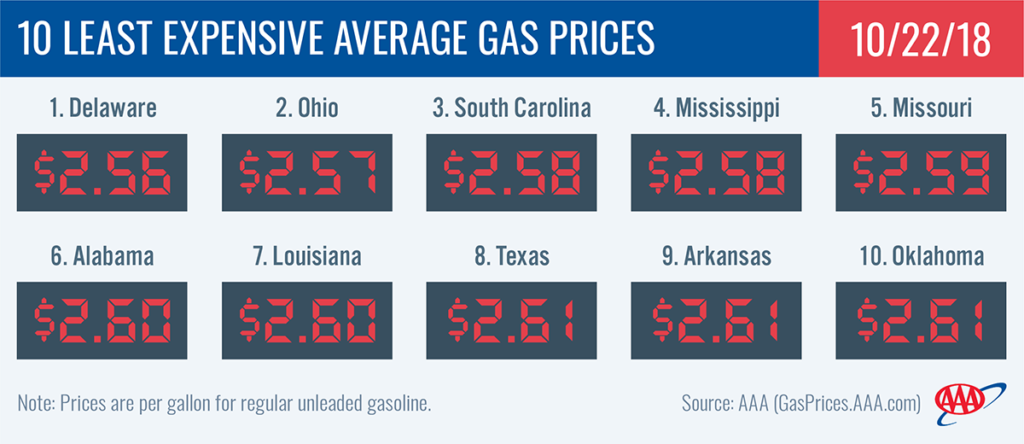Today’s price is also four cents cheaper than last week, the same price as last month and 39- cent more than this time last year.
Reduced refinery runs, due to peak maintenance season, have contributed to stable gasoline inventories amid lower demand, which is a contributing factor driving gas prices down.
“Motorists across the country are seeing gas prices more than a dime cheaper than last week, with 41 states having less expensive state averages on the week,” said Jeanette Casselano, AAA spokesperson. “Prices are falling despite market concerns about global supply and geopolitical tensions, but that could change later this month ahead of the U.S. announcement of imposed sanctions on Iran.”
Quick Stats
- The nation’s top 10 least expensive markets are: Delaware ($2.56), Ohio ($2.57), South Carolina ($2.58), Mississippi ($2.58), Missouri ($2.59), Alabama ($2.60), Louisiana ($2.60), Texas ($2.61), Arkansas ($2.61) and Oklahoma ($2.61).
- The nation’s top 10 largest weekly decreases are: Ohio (-12 cents), Delaware (-10 cents), Michigan (-10 cents), Indiana (-10 cents), Kentucky (-8 cents), Iowa (-7 cents), Maryland (-7 cents), Illinois (-7 cents), Oklahoma (-7 cents) and Missouri (-6 cents).
West Coast
Motorists in the West Coast region are paying the highest prices for retail gasoline in the country, with six of the region’s states landing on the nation’s top 10 most expensive list. Hawaii ($3.90) is the nation’s most expensive market, followed by California ($3.82), Washington ($3.54), Alaska ($3.39), Oregon ($3.38), Nevada ($3.29), and Arizona ($2.92). On the week, most prices are flat. However, Hawaii and Alaska have seen the largest increases, gaining two cents each.
The Energy Information Administration’s (EIA) weekly petroleum status report showed West Coast gasoline stocks decreased slightly to 27.6 million bbl during the week that ended on October 12. Stocks are approximately 1.5 million bbl lower than where they were at this time last year, which could cause prices to spike if there is a supply challenge in the region this week.
Great Lakes and Central
Seven Great Lakes and Central states land on this week’s top 10 list with the biggest declines for a second week: Ohio (-12 cents), Michigan (-10 cents), Indiana (-10 cents), Kentucky (-8 cents), Iowa (-7 cents) Illinois (-7 cents) and Missouri (-6 cents).
In the region, South Dakota ($2.89) has the most expensive gas price average this week, followed by North Dakota ($2.86) and Illinois ($2.82). With the significant price drops this week, Ohio ($2.57) and Missouri ($2.59) have the cheapest price in the region and rank among the top 10 least expensive pump prices in the country.
Gasoline inventories drew by 456,000 bbl on the week, a factor lending to cheaper prices in the region. Despite the decrease, inventories sit at a 3.3 million bbl year-over-year surplus.
Mid-Atlantic and Northeast
On the week, pump prices are as much as a dime cheaper across Mid-Atlantic and Northeast states. Delaware (-10 cents) and Maryland (-7 cents) saw the largest declines of all states in the region, landing on the top 10 list of states with the largest weekly change.
With the large decline in Delaware ($2.56), the state’s average ranks as the cheapest in the country, a rare occurrence for the state. It is the cheapest in the region followed by Virginia ($2.63) and Tennessee ($2.64).
With a draw of 602,000 bbl, gasoline inventories in the region register right at the 70 million bbl mark, according to EIA data. The small drop is helping to drive gas prices down. Notably, at 70 million bbl, the region is sitting on a 12.1 million bbl year-over-year surplus underscoring the nation’s high gasoline production rates this year.
South and Southeast
Gas prices continue to decline across South and Southeast states this week, dropping 2 to 6 cents for all states. Oklahoma (-6 cents) saw the largest pump price drop on the week. Prices are a nickel cheaper in Louisiana ($2.60) and Texas ($2.61). Influencing part of the cheaper prices is that all Colonial pipeline and terminal operations in the Southeast and Mid-Atlantic have returned to normal following Hurricane Michael.
Despite this week’s cheaper prices, state gas price averages are significantly more expensive than a year ago with Arkansas (+41 cents), New Mexico (+38 cents) and Alabama (+38 cents) seeing the largest year-over-year differences.
This week’s 229,000 bbl decline pales in comparison to the previous two weeks, which each saw a more than 1 million bbl draw. The small drop in the South and Southeast region is not surprising given that it reflects the impact from Hurricane Michael for the week ending October 12, according to EIA.
Rockies
On the week, Colorado (- 3 cents) was the only state to see a change in gas prices. All other pump prices remained stable. All five Rockies states carry among the 15 most expensive state gas price averages in the country: Idaho ($3.11), Montana ($3.01), Utah ($3.01), Wyoming ($2.95) and Colorado ($2.92).
Gasoline inventories remained relatively stable at 6.7 million bbl. According to EIA inventory data, the Rockies region current inventory level is at a deficit compared to this time the last two years.
Oil market dynamics
At the close of Friday’s formal trading session on the NYMEX, WTI increased 47 cents to settle at $69.12. The crude market mostly saw losses last week following EIA’s latest weekly petroleum report, which showed domestic crude inventories grew by 6.5 million bbl. Total crude inventories now sit at 416.4 million bbl, marking the fourth week of consecutive growth and highest level since late June. The larger-than-expected growth in crude levels shocked the market, leading crude prices to fall. This week, prices could rise again due to concerns about U.S.-Saudi Arabia relations and upcoming U.S.-imposed sanctions on Iran’s crude exports.
In related news, Baker Hughes, Inc. reported that the U.S. gained four oil rigs last week, bringing the total to 873. When compared to last year at this time, there are 137 more rigs now than in 2017.
Motorists can find current gas prices along their route with the free AAA Mobile app for iPhone, iPad and Android. The app can also be used to map a route, find discounts, book a hotel and access AAA roadside assistance. Learn more at AAA.com/mobile.


